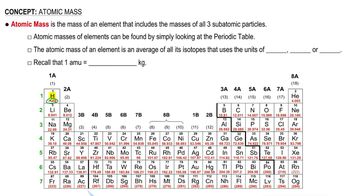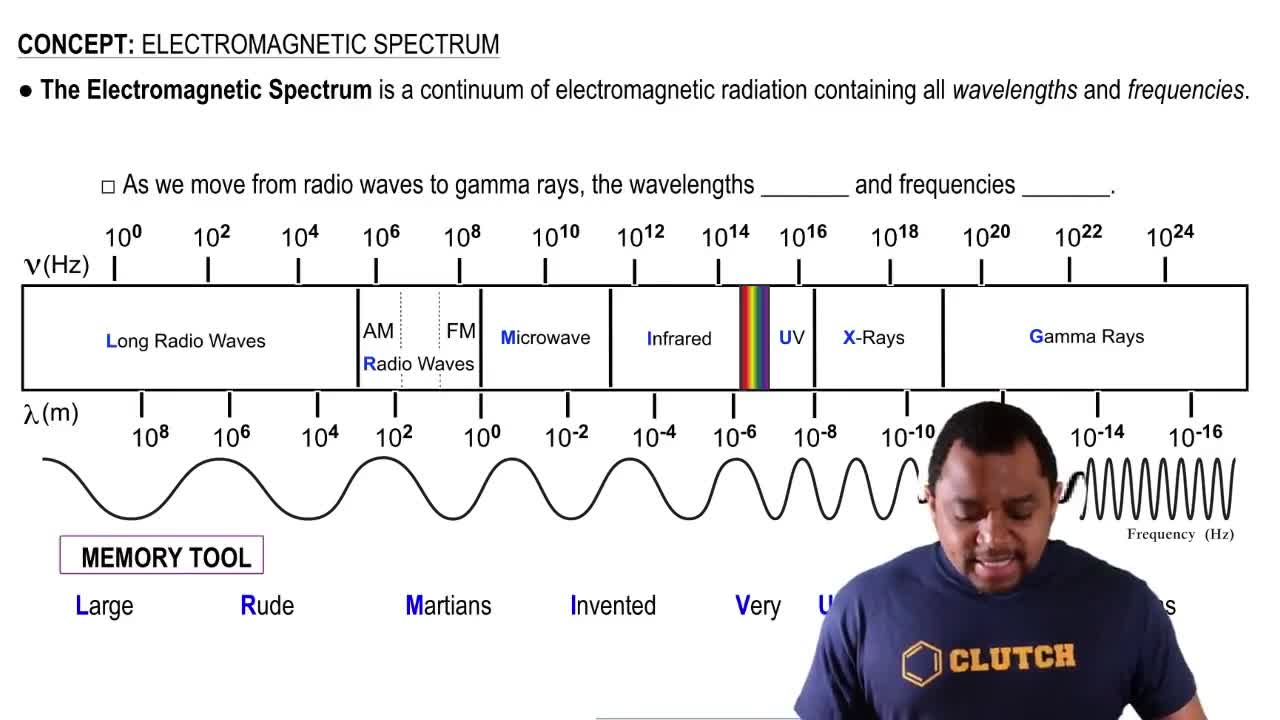Classify each element as an alkali metal, alkaline earth metal, halogen, or noble gas. a. F b. Sr c. K d. Ne e. At
Ch.2 - Atoms & Elements
Chapter 2, Problem 81
The atomic mass of fluorine is 18.998 amu, and its mass spectrum shows a large peak at this mass. The atomic mass of chlorine is 35.45 amu, yet the mass spectrum of chlorine does not show a peak at this mass. Explain the difference.
 Verified step by step guidance
Verified step by step guidance1
Understand the concept of isotopes: Isotopes are atoms of the same element that have the same number of protons but different numbers of neutrons. This difference in neutrons results in different atomic masses for the isotopes.
Recognize the natural abundance of isotopes: Some elements, like fluorine, have only one stable isotope (fluorine-19), which is why its mass spectrum shows a large peak at its atomic mass of 18.998 amu.
Examine the isotopic composition of chlorine: Chlorine has two stable isotopes, chlorine-35 and chlorine-37, with atomic masses of approximately 34.97 amu and 36.97 amu, respectively. These isotopes exist in nature in a ratio of about 3:1.
Analyze the mass spectrum of chlorine: Due to the presence of two isotopes, the mass spectrum of chlorine shows two peaks corresponding to these isotopes, rather than a single peak at the average atomic mass (35.45 amu).
Understand the calculation of average atomic mass: The average atomic mass of an element is calculated based on the masses of its isotopes and their relative abundances. For chlorine, the average atomic mass is closer to the mass of the more abundant isotope (chlorine-35), but the individual isotopic masses are what appear in the mass spectrum.

Verified video answer for a similar problem:
This video solution was recommended by our tutors as helpful for the problem above.
Video duration:
4mWas this helpful?
Key Concepts
Here are the essential concepts you must grasp in order to answer the question correctly.
Atomic Mass and Isotopes
Atomic mass is the weighted average mass of an element's isotopes, measured in atomic mass units (amu). Fluorine has a single stable isotope, which corresponds closely to its atomic mass of 18.998 amu, resulting in a prominent peak in its mass spectrum. In contrast, chlorine has multiple isotopes, primarily chlorine-35 and chlorine-37, which leads to a distribution of peaks rather than a single peak at its average atomic mass.
Recommended video:
Guided course

Atomic Mass
Mass Spectrum Interpretation
A mass spectrum displays the relative abundance of ions as a function of their mass-to-charge ratio (m/z). Peaks in the spectrum correspond to specific isotopes or molecular fragments. For chlorine, the presence of multiple isotopes results in several peaks, reflecting the different masses of its isotopes, rather than a single peak at the average atomic mass.
Recommended video:
Guided course

Electromagnetic Spectrum
Relative Abundance of Isotopes
The relative abundance of isotopes affects the appearance of a mass spectrum. Chlorine's atomic mass of 35.45 amu indicates a mixture of isotopes, with chlorine-35 being more abundant than chlorine-37. This abundance ratio leads to distinct peaks in the mass spectrum, rather than a single peak at the average atomic mass, as seen with fluorine.
Recommended video:
Guided course

Isotopes
Related Practice
Textbook Question
2
views
Textbook Question
Which pair of elements do you expect to be most similar? Why? a. nitrogen and oxygen b. titanium and gallium c. lithium and sodium d. germanium and arsenic e. argon and bromine
1
views
Textbook Question
An element has two naturally occurring isotopes. Isotope 1 has a mass of 120.9038 amu and a relative abundance of 57.4%, and isotope 2 has a mass of 122.9042 amu. Find the atomic mass of this element and identify it.
3
views
Textbook Question
An element has four naturally occurring isotopes with the masses and natural abundances given here. Find the atomic mass of the element and identify it.
Isotope Mass (amu) Abundance (%)
1 135.90714 0.19
2 137.90599 0.25
3 139.90543 88.43
4 141.90924 11.13
